How to unclog a blocked toilet with or without a plunger
Here’s how to unclog a blocked toilet to prevent it from overflowing with these four easy methods.
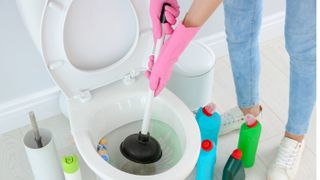
It’s always a nuisance when our toilets won’t flush properly. When this happens, you’ll need to know how to unclog a blocked toilet with or without a plunger to avoid a messy (and smelly) disaster!
Over time, toilets can get clogged with waste, excess tissue paper and other non-flushable items that end up stuck in the curved toilet trap. This blockage will prevent anything else from sliding down the pipes into the sewer, which can also lead to unpleasant odors. Knowing how to unclog a blocked toilet may seem like an unpleasant chore, however, if you don’t act promptly, you’ll be faced with an overflowing toilet, or worse, costly plumbing issues.
Just like knowing how to unclog a drain, you can easily unclog a blocked toilet with a few household items. What’s more, this can save you time (and embarrassment), especially when guests visit.
Follow our quick and easy steps on how to unclog a blocked toilet with or without a plunger.
How to unclog a blocked toilet with dish soap and water
Rubber gloves
Baking soda
White vinegar
Hot water
Dish soap
Toilet/flange plunger
Snake/auger
Old towels
1. First, pour ¼ cup of dish soap down the toilet bowl and let it soak for around 25 minutes. Dish soap is specially formulated to break down hard particles, and will make it more slippery. Do not use soap bars or shampoos as these contain fat, which will only make the blockage worse.
2. Follow this with a gallon of hot water from your bathroom faucet, and slowly pour down the toilet. Once combined with the dish soap, this should help break or dissolve the blockage. However, only do this if there’s no risk of overflowing your toilet. Never pour boiling hot water from the kettle into the toilet, as this may crack the porcelain or ceramic structure, and cause damage.
3. Finally, flush your toilet to find out if the blockage has been dislodged and has now disappeared down the pipe.
Sign up to get the BEST of Tom’s Guide direct to your inbox.
Upgrade your life with a daily dose of the biggest tech news, lifestyle hacks and our curated analysis. Be the first to know about cutting-edge gadgets and the hottest deals.

How to unclog a blocked toilet with baking soda and white vinegar
1. First, pour one cup of baking soda directly into the toilet bowl. When sprinkling, make sure to cover all of the surface. The baking powder should sink to the bottom of the toilet bowl.
2. Next up, slowly pour two cups of white vinegar into your toilet bowl. Combined with the baking soda, this will start to bubble up due to the chemical reaction between the two substances.
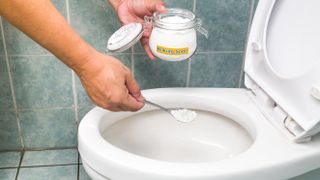
3. Let the solution sit for about one hour to allow time for the mixture to get to work in breaking up any clogs and helping them to easily slide down the pipe.
4. Finally, flush the toilet to see if it this has successfully unclogged it.
Baking soda and vinegar is also a natural deodorizer, and good for plenty of other cleaning tasks. Read here if you want to know what makes baking soda and vinegar so good at cleaning.
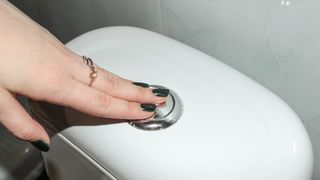
How to unclog a blocked toilet with a plunger
1. First, lower the plunger into the toilet, ensuring it’s at an angle so the cup fills up with water. Push down gently to remove air in the flange, and create a seal. It’s best to buy the correct flange plunger designed to specifically deal with toilet blockages.
2. Using both hands, carefully plunge up and down with a push-pull motion. Repeat this motion about five to six times before pulling the cup off the hole. This creates a combination of compression and suction in the drain to quickly dislodge any blockages.
3. Finally, flush the toilet to see if it has worked. If not, open the tank at the top of your toilet, reach in and push the flapper down over the hole. This will prevent any water overflowing the toilet bowl. Then, repeat if necessary.
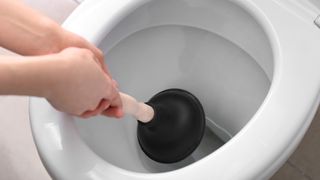
How to unclog a blocked toilet with a toilet snake/auger
A toilet auger or snake is a long wire coil with a corkscrew-shaped tip to feed into the pipes until it locates the clog. Here's how to use one to unclog a blocked toilet.
1. Prepare the area by laying down old towels or sheets to prevent any messy spills.
2. Place the end of the toilet auger into the bowl, pointing towards the drain. Use the crank handle to extend the auger’s cable to go down further into the drain.
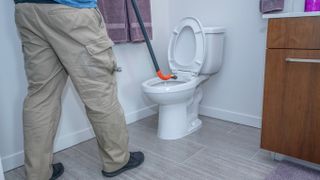
3. Once the cable feels some resistance, that means you have located the cause of the blockage and can stop cranking.
4. Finally, push the auger back and forth a few times to break down the clog so your toilet can flush properly. Take care when doing this to avoid scratching or damaging your ceramic or porcelain toilet bowl.
Bear in mind, these methods may only be short-term solutions. If none of these unclogging methods work, or you continue to have a clogged or overflowing toilet, always call in a plumber as it may indicate a serious problem that can only be fixed by a professional.
What you should never flush down the toilet
Although we tend to think our toilets can flush almost any waste, that's not the case — and clogs are often caused by something unsuitable having been flushed. Here are some items you should never flush down the toilet (don’t even think about it!).
Paper towels and tissues — These are made to absorb water and cannot dissolve when flushed.
‘Flushable’ wipes — They may claim to be ‘flushable’, but these do not break down quickly when submerged in water.
Excess toilet paper — A common culprit, but too much toilet paper used in one go will often lead to blockages. Try to flush as you go along, or only use what you need to limit any clogs.

Feminine products — Sanitary towels and tampons tend to expand in water, so can cause havoc with the toilet drain. Always put used feminine products inside a bag and dispose of them in the trash.
Hair and dental floss — These may seem harmless, but hair and dental floss can stick to the inside of your pipes, causing a build-up. Always throw away hair and dental floss in the trash bin.
Cooking oils, fats and grease — Although these are initially in liquid form, these can harden and attach to the pipes. If they build up, this will cause a clog, and prevent anything else going down the drain. Wait for the oils to cool and solidify before throwing them out in the trash bin.
Once you've unclogged your toilet, you'll also want to know how to clean your toilet to make it look like new. Also check out our guide on how to clean your shower curtain, as well as how to clean a glass shower door and how to unclog a shower drain.

As the Homes Content Editor, Cynthia Lawrence covers all things homes, interior decorating, and garden-related. She has a wealth of editorial experience testing the latest, ‘must-have’ home appliances, writing buying guides and the handy ‘how to’ features.
Her work has been published in various titles including, T3, Top Ten Reviews, Ideal Home, Real Homes, Livingetc. and House Beautiful, amongst many.
With a rather unhealthy obsession for all things homes and interiors, she also has an interior design blog for style inspiration and savvy storage solutions (get rid of that clutter!). When she’s not testing cool products, she’ll be searching online for more decor ideas to spruce up her family home or looking for a great bargain!
